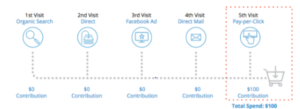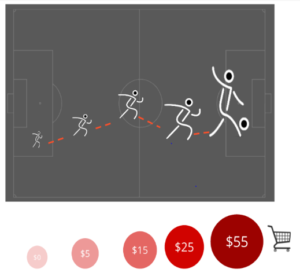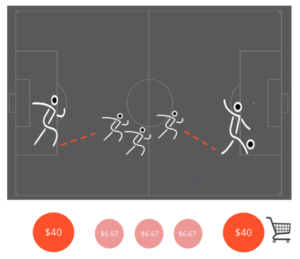Overview of Types of Attribution for Affiliate
At AIM there’s always a lot of discussion around attribution. With a diverse team, a range of different marketing backgrounds, and a wide array of current clients across various industries, there’s a vast amount of experience and perspectives that serve to drive ideation and recommendations to best optimize the performance marketing efforts of our clients. Additionally, we implement and execute these theoretical concepts for our clients, sifting through the complexity of technology, platforms, and different software available to ensure that the right tools are utilized to meet our client’s business objectives.
Given the interest, excitement, and opportunities that often surrounds this topic of attribution, we thought it would be helpful to lay out a series of blog posts to shed some light on key questions that the AIM team often gets from clients. We’ll first take you through an overview of exactly what attribution is and what some of the major components that you need understand are, as well as some of the initial challenges to consider.
In our second post, we’ll focus more directly of the Performance Marketing space, and we’ll take a look at some of the major affiliates networks and tracking platforms to help break-down their major differences to help you select what’s best for your business. And lastly, we’ll explore some complex questions regarding attribution and how best-in-class affiliate marketing teams have been testing new ideas to ensure that the performance of their program, and their specific publishers is accurately reflected and aligns with their business objectives.
No matter what your role is, if your work is, in anyway related to the performance of your product or service, a high level understanding of attribution is necessary. We hope that this series of posts will help provide you with a strong overview to help you move towards meeting your business needs.
What is Attribution?
Attribution is the process of assigning a value to each touch-point throughout the click path of the consumer’s buying cycle. In essence, it’s understanding your data to credit the proper source that drove the conversion, sale or desired action that you would like consumers to take.
Attribution provides us with more data to be able to have additional insight into what channels perform best, therefore giving marketing teams a clearer picture of where to spend the next dollar.
Overall, there are several different approaches to attribution which can help to provide a business with the value of the different touch-points in a customer’s journey. The most common are:
- Intra-channel: This is when attribution is looked at only within one channel. For example, affiliate marketers typically work within a specific network that provides a home for all of the different publishers (partners) from coupon and loyalty sites to content, social influencer and blog sites. Intra-channel attribution would then look at the value of each individual affiliate partner within a customer’s click-stream, ignoring any touch-points that happen outside of the affiliate channel.
- Multi-channel: Traditionally, attribution across multiple channels, both on and offline was considered multi-channel attribution. This could mean that a company sends out a catalog to customers and then merges this offline touch-point with their email touch-point, as well as other advertising efforts, to create the customer’s click stream that is then used to give credit accordingly. This assumes that customers have their preferred channels and devices for shopping and that its important for the business to utilize and maximize each channel and device individually to optimize performance.
- Omni-channel: Omni-channel is really the evolution of multi-channel, where companies see the entire customer experience, not the channel or device, as central to driving a conversion. This idea believes that customers will seamlessly move through different channels, online and offline, as well as different devices such as a desktop computer, tablet or mobile phone. An omni-channel merchant must ensure that this entire experience is consistent and integrated, with teams often working more closely together to achieve this. While multi-channel attribution would likely consider catalog customers to be largely driven by the catalog, omni-channel attribution would be more apt to look at the entire experience holistically without preference for one channel or another, rather possible preference where the touch-point occurs within the click stream.
What are some of the major types of attribution models?
First Click, Last Click:
- First Click is when 100% of the attribution credit (value) is given to the channel that provided the first click in the consumer’s journey to fulfilling the desired outcome (conversion). This puts the emphasis on the ‘introducer’ as the main driver of your desired outcome.
- Last Click is when 100% of the attribution credit (value) is given to the channel that provided the last click in the consumer’s journey to fulfilling the desired outcome (conversion). This is the complete opposite of first click and traditionally the ‘closer’ has been the most highly prioritized by companies setting up basic attribution models.

Image Credit: Impact Radius https://www.impactradius.com/blog/choose-marketing-attribution-model/
Fractional (Linear, Time Decay, Position):
- Linear is when every step (often a click) within the customer journey is given equal credit for the desired outcome. For example, if aconsumer purchased a $100 guitar and clicked on an organic search ad first, then an internal email, followed by a paid search ad, and finally an affiliate coupon site, each of these sources would receive credit as driving 25% of the sale, of $25. This incorporates the idea that equal value should be placed across the ‘introducer’, ‘ assist’ and ‘closer’.

Image Credit: Impact Radius https://www.impactradius.com/blog/choose-marketing-attribution-model/
- Time Decay means that, similar to Linear, all touch points receive some credit for the conversion, however, as the touch points get closer to the actual sale, they receive a higher portion of the credit. The amount of credit varies based on the rules set-up by the business but the key is that the ‘closer’ or final touch-points are more highly valued than earlier ones.

Image Credit: Impact Radius https://www.impactradius.com/blog/choose-marketing-attribution-model/
- Position Based means that the business values the first click (introducer) and the last click (closer) at a higher rate than any interactions that happened in the middle (assist) of the customer’s journey. This could mean that 40% of credit is given to the first click, 40% given to the last click and the remaining 20% is divided up amongst any of the remaining clicks that happened in the middle.

Image Credit: Impact Radius https://www.impactradius.com/blog/choose-marketing-attribution-model/
Other
- Last-to-cart is essentially the same concept as last click, except the click that determines credit for the sale is based on the final click before a product was added to the cart, not before the actual transaction takes place. This was developed in large part as a response to a coupon and offer driven marketplace, where the last click before the actual transaction is often just to pick up a coupon code for a product that was going to be bought regardless. As the objective of attribution is to properly determine ‘what’ drove the person to purchase, this logic assumes that a final coupon code tends to be less incremental in nature.
Key challenges?
No attribution model is perfect: Despite all the technology and tools available, no model is completely perfect. Whether it’s first or last click, Linear, Time Decay, Position or something custom that your company developed specifically to meet their needs, it will never be 100% reflective of what truly drove the desired outcome. It will, however, allow you to gain more insight into what is driving your business. It’s not meant to provide all the answers, as you will need your own internal reporting and analytics to cross compare, or replace the testing that should be an everyday component of your marketing plan.
LTV (Life-time Value): One of the big mistakes that companies often make is that they overlook LTV, a key metric that needs to run as a sort of ‘check and balance’ to any attribution model. For example, while a last click attribution model may suggest that performance is strong across specific types of affiliates such as coupon sites, LTV analysis may actually show that the value of these customers over a longer period is quite weak and would drive the company to make different conclusions regarding where to spend their money. Alternatively, top of funnel partners such as bloggers, review sites or forums, could showcase a lower volume in sales for that month, but be the most valuable partners longer term when LTV is taken into account.
Missing data and tracking (i.e. offline): While developments in technology have increased the accessibility of attribution models to most companies, it has not solved for the lack of tracking associated with many offline channels such as events, PR/press, TV/radio. These channels can be a huge part of your business and it can be extremely challenging to assign a clear value to these. While many companies do what they can by collecting business cards / email at events, analyzing geographic traffic bumps based on local media or simply relying on customer reported data, this data is often vague, underreported, and difficult to synch with your online channels. In the performance marketing space, this can be overcome with exclusive URLs, 1800 numbers and vanity codes that show where the transaction actually came from.
Data Sources: With most companies using a variety of tracking tools such as Google Analytics, an affiliate network, other paid media tools, internal database source code tracking and a variety of other options, aligning on one data source can be tricky. Different tools offer different benefits and for example, while Adwords may be necessary for your paid search team to manage and optimize campaigns, tracked performance results will most likely differ from any other attribution model that looks across various channels. The ideal is to have one reliable data source. If that is not possible, then it’s important to layer your attribution model on top of the different incoming sources to ensure that the algorithm is properly de-duping and crediting the proper sources based on your logic. Don’t forget to feedback this data to your channel leads, as additional insights regarding the incremental value of paid search campaigns can drastically change the conclusions that may be drawn solely based on Adwords.
Company Politics: At the end of the day, the resulting data from your attribution model will help inform the entire marketing and executive teams about the channels that are truly contributing to your desired goals. This is exactly what you want, but brings upon challenges within most organizations that are usually made up by different interests, responsibilities and perspectives on what drives the business forward. For example, a first click model will likely benefit specific channels, leading the organization to prioritize and spend more money in those channels, to the delight of those channel leads. This can be a sensitive topic to negotiate and agree on amongst various constituents but by maintaining clear overall business objectives, different parties should be able to come to an agreement.
In summary, attribution is an evolving topic that is changing as fast as the technology that powers it. There’s no one best solution for every business, and it takes strategic thought and discussion across various business interests, to agree on a model that will work best to achieve the desired business goals and objectives. As we continue to explore the topic in follow-up posts, we hope that some of the questions, concerns and confusions begin to clear up, and we can provoke some additional thought into what makes the most sense for your business.











